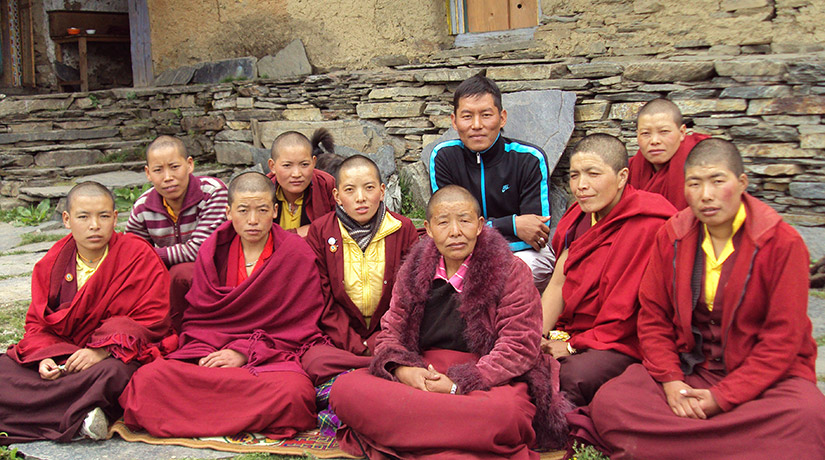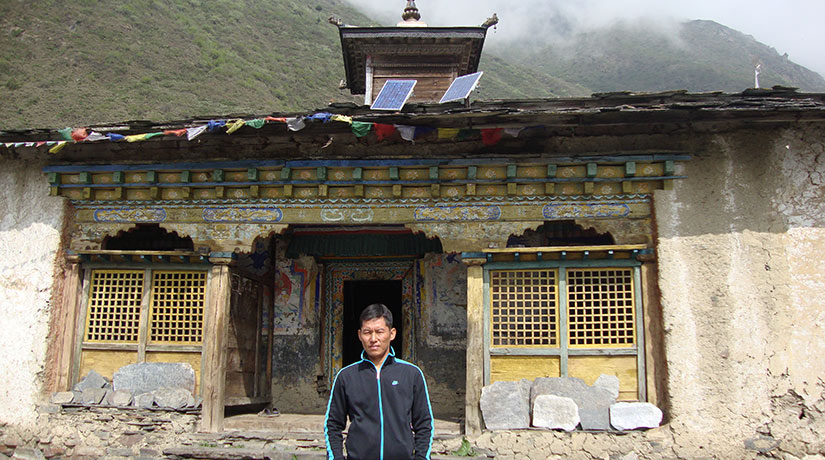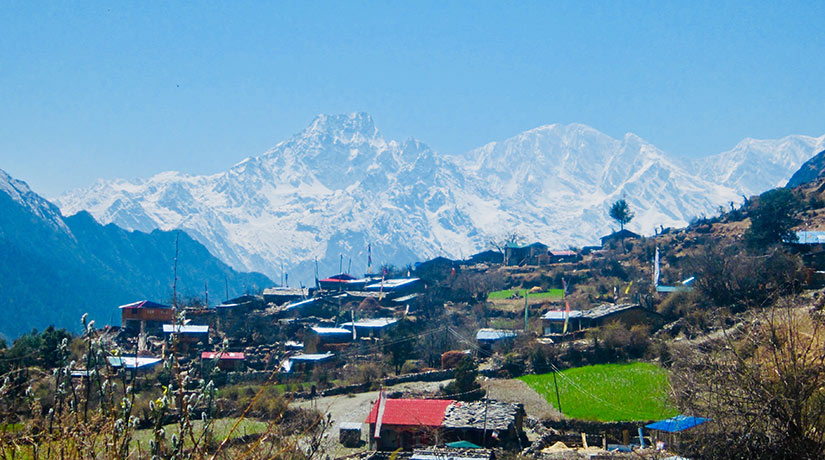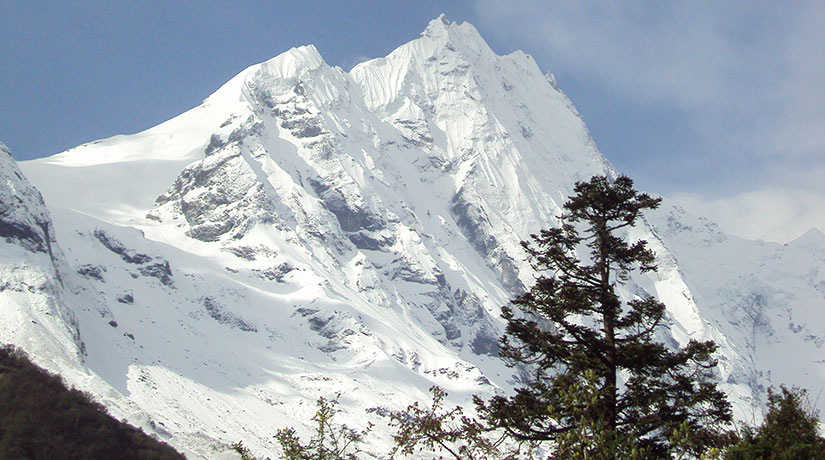Trip Facts
General trp informationsMin. 2 Pax
Hotel/Lodge
B,L,D
Private Vehicle/Bus
Manaslu trekking with Tsum Valley is known for sensational mountain vistas, unrivaled fascinating culture and tradition. The trek offers biological diversity, for example, the lower part is covered with lush green forests and flowering rhododendrons in the spring. The gushing Budhi Gandaki River and its tributary river Syar Khola whose source resides in high mountains, cuts gorges and tight valleys. Not to forget the most impeccable scenery you can imagine of far reaching mountain views with Mt. Manaslu and Ganesh Himal.
Among the less known, remote and pristine one, hidden gem, visiting the Tsum Valley as Hidden Valley of Happiness, is referred to in ancient Buddhist texts as a sacred pilgrimage site and practice of Buddhism even at the time of warfare and political unrest, prophesied by Guru Padma Sambhava in 8th century. Actually both enchanted Tsum and Nubri valleys are rich in ancient art, culture and religion with several unique monasteries, artistic Chorterns and Mani walls made up stone slabs inscribed with Buddhist prayers.
Both valleys are considered to have religious significance. Tsum valley primarily because of Yogi Jetsun Milarapa, a legendary Buddhist sage, is said to have meditated in sacred cave, known today as Piren Phug (Pigeon Cave), is near a village called Lamagaun. According to one tale, the sage, who often disguised himself to beg for food in the village, once became victim to the misbehavior of one of the village women who gave him a meager half-piece of bread. Soon thereafter, this woman’s field became totally barren. Today, too, you’ll see a small plot of land in the village in which nothing grows.
The trek spans from 600 meters to 5160 meters elevation – one of the Nepal’s Himalayan gems. Undoubtedly this Manaslu trekking with Tsum valley suits best to those who are looking for off the beaten track and challenging adventure in Nepal. It is one of the restricted areas in Nepal, and it is mandatory to hire a licensed trekking guide. It is advisable not to miss this trekking route, which is part of the Great Himalayan trail and easily done in 21 days staying in the local teahouses. Also, it is known as the best alternative of the classic Annapurna circuit.
Manaslu with Tsum Valley trek with attractive perspectives of Shringi Himal 7161m, Himalchuli 7893m, Ngadi Chuli (Peak 29) 7871m, Mt. Manaslu 8163m, Ganesh Himal II 7118m, Simnang Himal 6251m, Saula Himal 6235m, Cheo Himal 6812m, Himlung Himal 7126m and other beautiful peaks. Offering panoramic views of lakes, different species of birds, plants, mammals, vegetation, waterfalls and flora fauna. This region is a natural habitat for many elusive wild animals. Such as the snow leopard, grey wolf, musk deer, Himalayan Tahr and blue sheep – Keep your eyes open!!
We start our Manaslu trek from Lapubesi after a drive from Kathmandu via the Aarughat. Then trekking along the Budhi Gandaki River. The trail meanders, scrambles and climbs its way along the confines of the valley. Much of the Manaslu trekking with Tsum valley is in the region known as Tusm Nubri, an area of strong Tibetan influence with the trade route between the regions. As we trek higher the Hindu culture is being replaced by Buddhist features of Mani walls, Khanyi gates, Chortens and monasteries as does the topography changes.
Manaslu trek officially opened for trekking in 1991 and Tsum Valley in 2008. Mt. Manaslu 8163m is one of eight thousandar out of eight in Nepal. Larkya pass is the highest vantage point in this trek. Classic and tough ancient salt trade route that links literally Manaslu to Annapurna region. The view from the Larkya pass is simply Superb. Himlung, Cheo himal, Larke peak, Annapurna II and Mt. Manaslu can be captured from the pass. After crossing the Larkya-pass 5160m and entering Annapurna region we descent through the beautiful alpine valley at Bhimthang the Manaslu trek descents along the Dudh Khola, the milky river that spills into the Marsyangdi and joints the classic Annapurna circuit trail at Dharapani. However, Manaslu circuit trekking further takes down valleys through Tal village - Chamje – Ghyarmu, Bahun danda, Ngadi, Bulbule to Besisahar or take jeep from Dharapani to Besisahar. From Besisahr to Kathmandu you can drive via public bus/private jeep or car as your demand. We offer affordable price with local manual and sturdy porters in Manaslu circuit trek with Tsum valley at any time of our client’s request You simply need 24 days for this around Manaslu trek with Tsum valley from arrival to departure from Kathmandu.
Outline Itinerary
Day 01: International arrival Kathmandu 1350m
Day 02: Manaslu trek preparation, issue restricted area permit, Kathmandu 1350m
Day 03: Kathmandu – Soti khola 700m via Arughat 7-8 hrs
Day 04: Sotikhola to Machhakhola 869m (5-6 hrs)
Day 05: Machhakhola to Jagat 1400m (7-8 hrs)
Day 06: Jagat to Lokpa 1860m
Day 07: Lokpa to Chumling 2386m
Day 08: Chumling to Chhokang paro
Day 09: Chhokang paro to Nile
Day 10: Nile to Mu Gumba
Day 11: Mu Gompa to Rachen Gumba
Day 12: Lama Gaun – Lungdang
Day 13: Gumba Lungdang to Lokpa
Day 14: Lokpa to Deng (1,860m/6,102ft)
Day 15: Deng to Namrung 2630m
Day 16: Namrung to Lho 3180m (4 hrs)
Day 17: Lho to Sama gaun 3525m (4 hrs)
Day 18: Acclimatization Day in Samagaun
Day 19: Samagaun to Samdo 3875m (4hrs)
Day 20: Samdo to Dharmasala
Day 21: Dharamsala to Bhimthang 3590m (7-8 hrs)
Day 22: Bhimthang to Tilije 2300m (6-7hrs)
Day 23: Tilije to Dharapani then drive to Besisahar 760m (6-7hrs)
Day 24: Besisahar to Kathmandu 1350m (6-7 hrs)
Day 25: Rest day in Kathmandu
Day 26: International Departure.
What's included?
- Manaslu Restricted Area Permit, Manaslu Conservation Area Permit, Tsum Valley Permit and Trekkers Information Management System (TIMS) fees or Local Govt. Entry Fee
Teahouse (sharing twin or double room) - 21 days Trek is accompanied by a well experienced English speaking guide and porters
Note: - one porter will carry a maximum weight of 25kgs, 1 porter for every 2 guests and 1 sherpa will accompany every 6 guests). Includes all meals, accommodation, allowance, insurance of guide and porter & porter equipment.
- 20 nights accommodation in local lodges sharing twin room on full board according to itinerary. (B, L, D)
- Bus or Jeep fares Kathmandu – Sotikhola, Dharapni to Besisahar Jeep, Besisahr – Kathmandu on Bus or Car on your request.
- Guide and porters bus fares or Jeep and accommodation.
- Salary, insurance, food, accommodation of Guide and Porter.
- Airport pick up/ by private vehicle.
- Loan of sleeping bag, duffel bags and trekking poles.
- 03 night’s accommodation at local 3 star hotel in Kathmandu sharing twin / double room on bed and breakfast basis.
- All government VAT.
Note: We will provide the best available Local Lodges during the adventure based on the room availability. please also expect that some of local lodges in higher elevation may not have attached bathrooms and extremely basic services. Hence, clients will have to adjust on common bathrooms as well. However, we will try our best to allocate the rooms with attached bathroom wherever available
What's not included?
- International airfares.
- Nepal visa fee.
- Travel insurance / Medical evacuation and Helicopter Rescue in case of emergency.
- Personal trekking Equipment not mentioned.
- Tips for trekking staffs and driver.
- Any others expenses which are not mentioned in Price Inclusion section.
- Any beverages, including mineral water, alcohol drinks, soft drinks etc. unless otherwise specified.
- Any items of personal nature such as telephone bills, laundry, bar bills.
- Services like accommodation, meals & transfers etc. in Kathmandu except listed in inclusion.
- The prices do not include: undue escalation in fuel prices, new taxes levies on hotels and transportation services or any hikes in entrance fees. Any large tax hikes and new levies shall be payable extra and shall be billed accordingly with prior notice.
- Sightseeing, dinner transfers, entrance fees in Kathmandu.
- Cost of Showers during trekking.
- Any other items not mentioned in the cost inclusion.
- Fleece liner, down jacket, rain poncho etc.
- Internet & Battery Charge.
International arrival Kathmandu 1350m
30 Min. Hotel BB
Welcome to Nepal!
Upon arrival, you will be greeted by Bodhi Adventures representative by marigold garland at the Kathmandu airport and transferred to your beautiful hotel. You will meet your leader and your local professional and qualified guide at 5 pm this afternoon and have a full briefing on your Manaslu adventure.
Enjoy your dinner on your own this evening.
Manaslu trek preparation, issue restricted area permit, Kathmandu 1350m
World Heritage Sightseeing in Kathmandu if you choose to, rest in your hotel, and prepare your equipment for the Manaslu Trek.
Kathmandu – Soti khola via Arughat
7-8 hrs Hotel
Leave early morning for the long drive from Kathmandu to Sotikhola, the starting point of the Manaslu Circuit Trek. Enjoy the drive through the Nepalese countryside, and through Arughat - a Gorkha community. Stop for lunch and try your first delicious Dal Bhat. Stay overnight in Sotikhola by the Budhi Gandaki River. (If you choose public bus then by 6:30am you have to be in public bus stand but if you choose a Private Jeep then you’ll be picked up in your hotel).
Sotikhola to Machhakhola 869m
5-6 hrs
Today on the Manaslu trek through shady Sal forests, and maybe spot some Gray Langoor monkeys. Following the Budhi Gandaki watercourse, we proceed up and down the steep rocky trails often having to let trains of loaded mules pass as they transport supplies between villages. Always remember to step to the ‘mountain side’ to let them pass on narrow trails. After passing through the villages of Lapubensi and Khanibensi foothill settlements, we finally arrive at the large Gurung town of Machhakhola.
Machhakhola to Jagat 1400m
7-8 hrs
We start our trek crossing Machhakhola (means fishy river) small stream by next to the mule loading station. The trail follows the Budhi Gandaki to Khorlabesi 970m. where espresso coffee beans grow, and then Tatopani (hot spring) 990m. where a hot spring gushes from under a sheer bluff. It then continues on the eastern bank of the Budhi Gandaki to Dovan 1070m. where we stop for lunch, then Thulo Dunga, and Yaru Bagar 1170m. The trail then crosses the Budhi Gandaki back and forth on suspension bridges to reach the entry gateway to the Manaslu Conservation Area, the Gurung town of Jagat, with it’s lovely flag stoned village square. There is a conservation area office, where restricted area permits are checked. It is also located close to the Tibetan border, so one starts to see the Tibetan Buddhist influences of prayer flags, Chortens (Stupa) and Mani walls (Prayers inscribed in slates and fixed in walls).
Jagat to Lokpa (2,240m/7,349ft)
6-7 Hrs
This day will take you finally into the entrance of Tsum Valley. The trail will cross the Budhi Gandaki River on a long suspension bridge and then up the side of the mountain to the village of Philim. From here, the villages become few and far between. The river continues to narrow until it comes to the confluence of the Syar Khola from Tsum valley, where Tsum Valley leads to the right. The village of Lokpa is the first of the Tsum Valley villages, which offers great views of Manaslu. Trekking time is 6-7 hours. The food and lodging at Lokpa is very adequate, and the store here is well stocked.
Lokpa may be the entrance to Tsum Valley, but the real entrance lies beyond the village in a deep narrow gorge. The trail from Lokpa drops down to the river valley and then up again to Gumlung. There are no villages between Lokpa and Gumlung. There is a small tea shop at Gumlung with is a welcome site. At Gumlung, the trail divides. Cross the Siyar khola and walk to the village of Chumling. Chumling has two places to stay, along with a gombe. Trekking time 5-6 hours.
Today’s trek will go from the lower to the upper valley. The trail follows along the Siyar Khola down to Domje and then rises over 500 meters to the largest city in Tsum Valley: Chhokang Paro. The trek takes between 6-7 hours. Of special interest is the pretty little village of Gho above Dumje. It has an unusual Gomba, and there is a store where you can buy tea and drinks. Spend the night in Chhokang Paro.
From Chhokang Paro to Nile, you will pass through a number of villages. This trail is the ‘highway’ through Tsum Valley. The valley is fertile here, although narrow, and you will be able to see the residents farming. Just past Lamagaun is Piren Phug or the Cave of St. Milarepa where his footprint is preserved in the rock. The trail continues upwards to the village of Nile. The trek 4-6 hours, with the trip to Piren Phug taking anywhere from 60-90 minutes. The cave is located on the side of the mountain, with great views of the valley from the cave monastery.
Mu Gompa is the northern most point on this trip, and is home to a large monastery. This monastery has rooms for visitors where you will spend the night with the monks. Today’s trek is shorter, only about 3-4 hours.
This day will take you from one monastery to another that is under the same Lama. Rachen Gompa is a large monastery, and the return trek will take around 3-4 hours. If you were unable to visit Piren Phug on day 7, this day will offer a second opportunity to visit this religious holy site.
Optional trail you also can walk visiting Dhephu Doma (Nunnery Gompa) takes extra 2 hours.
This trek is a long day, as you will leave the upper valley and at Domje, take the trail to Gumba Lungdang. Here is another gumba that allows visitors to spend the night. The views of the Ganesh Himal Mountains are outstanding from this point. There is no village from Domje to Gumba Lungdang. Trekking time is 7-8 hours
Another long day of trekking as you leave Lungdang to Lokpa; passes through Domje and back to Lokpa. The trail will drop back through the gorge that forms the entrance into Tsum Valley along the Siyar Khola. Spend the night again at Lokpa. Trekking time is 7-8 hours.
This day we retrace the same trail to Gampul after breakfast then we entered to Nubri valley along the Budhi Gandaki River. Crossing small teahouse places Nyak, Pewa we get to Deng.
Deng to Namrung 2630m
5-6 hrs
Today the trail passes through several villages like Rana, Bihi Phedi, Prok, Ghap etc. which have been rebuilding since the earthquake. We trek through the Prok Village, which is located on a plateau and has a viewpoint for Sringi Himal (7161m) From Prok we descend to Ghap, and then hike through a beautiful forest filled with fir, rhododendrons, azaleas, piers, rosehip, birds sound and Langoor monkeys. We finally arrive at Namrung which is a former customs post in the days of the salt route to Tibet. The Tibetan influences are heard in the local spoken dialects. In Namrung, one gets a different perspective of Sringi Himal and Ganesh Himal 7140m.
Namrung to Lho 3180m
4 hrs
Today is an easier day but the scenery no less stunning. Going through the beautiful plateau of Bhanzam with barley fields and stone houses, we will enter the village of Lihi. After lunch here, we cross the Hinang River, and then reach Lho which is dominated by the Ribung Gompa.
Lho to Sama gaun 3525m
4 hrs
This day takes you into the mountains with time to experience the surrounding commanding views and to acclimatize. Start the hike with a visit to the Ribung Gompa, and then head up a pine and rhododendron gully to reach Syala 3510m where we stop for tea and take in our first astounding perspective of Mt Manaslu 8163m Revel in the 360’ perspectives from here because of the deforestation of the plateau. After hiking on through a world of yaks, pastures, and stone huts, crossing the slope draining the Pung Gyen glacier, we finally reach the village of Samagaun. This is the largest village on the Manaslu circuit, and also the closest to Manaslu Base Camp. After lunch we do a short hike to Birendra Tal (a glacial lake at the base of Manaslu glacier), which is the starting point for the trail to Manaslu Base Camp.
This is a full rest day so that you can wash your clothes, read your book, and take a warm shower. It is also recommended that you do an acclimatization hike to Pung Gyen Gompa (6-7 hrs) or Manaslu Base Camp (9-10 hrs). While hiking watch for Himalayan Thar on the steep rock walls. Also explore the village of Samaguan and experience the local culture. See the many Mani walls, made of thousands of Mani (Jewel) stones inscribed with Buddhist prayers in Tibetan script and pictures.
Samagaun to Samdo 3875m
4 hrs
Today’s walk is brief because of the excessive elevation, but with exceptional mountain scenery. The trail heads to north, passing through juniper and birch forests, and then gets tougher as we start the yak trails. We pass through an extensive valley with long Mani partitions, and many marmots keeping watch from their burrows or sunbathing in the afternoon heat. After passing the starting point of the Budhi Gandaki River, we enter Samdo village. Samdo is a Tibetan refugee village, under the Samdo Himal 6335m and Samdo Glacier. The main pass to Tibet is over the Lajyang La Pass 5098m, sloping up the right hand valley. The Larkye pass is ahead and left. The pass to Tibet is currently closed, but stocks of timber are being carried up to Samdo by yak, in expectation of change.
Begin the path slightly uphill to the mythical Larkya Bazar, and from here, people head right to Tibet through Lajyang Bhanjyang 4998m and Gyala Bhanjyang 5375m, which has a flourishing marketplace. The large Larkye glacier coming from Mt. Manaslu is visible on the left, and the trail starts to ascend to the pass. We cross the Athara Saya Khola, and then go along the Larke Khola. Along the way maybe spot some Himalayan Blue Sheep or Bharal grazing on the slopes. They are the main prey of the elusive Snow Leopard, which lives in the higher alpine regions. After continuing the climb upwards we reach the mountain facilities at Dharamsala.
Dharamsala to Bhimthang 3590m
7-8 hrs
After an early wake up about 3am and breakfast, we make a short climb to reach a valley on the north side of Larkya glacier with exquisite views of Larkya peak. We ascend the massive lateral moraine of the glacier, which becomes quite steep just before reaching the pass. Leaving early camp allows us to reach the pass before the strong cold winds come up towards the late morning. From the top of the pass we have breathtaking views of Himlung Himal 7126m near Tibet, Kanguru 6981m, Annapurna II 7937m range and other peaks. The descent is quite steep to begin with, and in the snowy months may require the use of crampons. After several hours the trail flattens out into a wide delightful valley - a descent of 1400m over 3-4hrs. It ends at the very scenic Bhimtang, where the exquisite view of Manaslu makes every step worthwhile.
Bhimthang to Tilije 2300m
6-7 hrs
After a great sleep and hearty breakfast, the trek starts and after 25m we pass the Kechakyu Khola glacier and enter the Rhododendron wooded area. If you are here in March and April you will see the incredible display of Rhododendrons bloomings in full display. The view of Mt. Manaslu is equally impressive. The trail eventually leads towards to the Gurung village of Gho 2515m, and on to Tilije where there are better accommodation choices.
Tilije to Dharapani then drive to Besisahar 760m
6-7hrs Hotel
Exit the village on a stone path and descend rapidly to the Marsyangdi Valley in Thonje. You will then join the new road along the main Annapurna Circuit route in Dharapani 1963 mtrs. Here you will catch a public jeep all the way to Besisahar and overnight at a hotel.
Besisahar to Kathmandu 1350m
6-7 hrs
Besisahar is the district headquarters of Lamjung district. Here you will catch a private car, or public bus to Kathmandu and follow the Marshyangdi river, passing numerous Gurung, Magar and different villages to reach Dumre bazaar. Then follow along the Himalaya rafting Trishuli river to the capital. Be dropped off at your hotel, and have a good nights rest after completing the Manaslu Circuit Trek. Namaste.











